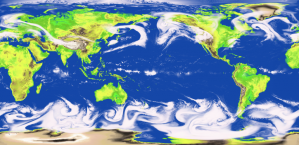5) Our understanding of the climate system is improved through observations, theoretical studies, and modeling.
 Output from a model of global atmospheric circulation.
Output from a model of global atmospheric circulation.The fifth principle provides the context for answering the question, “How do scientists know what they know about climate?”
While there is no single formal “scientific method” used throughout all sciences, in the study of climate, observations, theoretical investigations, and modeling all work together to improve our understanding and ability to predict future climate trends. It is important to realize that modeling and theoretical studies are legitimate tools in climate science as they are elsewhere in science: to say that a conclusion is based on a certain theory or a particular model is not to imply that it is uncertain or controversial.
Another important aspect of how scientists improve their understanding of climate is the peer review process. When scientists publish their research, they typically do so in a peer-reviewed journal, in a process whereby their peers evaluate their work to ensure that it meets a minimum standard of rigor. Publication in such a journal is the usual prerequisite for research to start to be evaluated, reproduced, and assessed by the scientific community. In climate science as elsewhere, the scientific consensus is based on the peer-reviewed research literature.
CLEAN’s “Teaching Essential Principle 5” provides overview of the content, why it is important, related pedagogical challenges, and examples of high quality resources by grade level.
Continue to the next section to find out how human activities are impacting the climate system.
